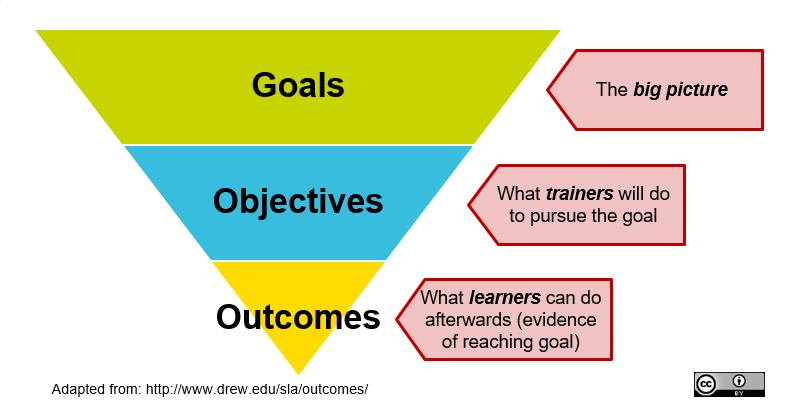Goals, objectives and outcomes
Developing training is iterative and will involve ongoing feedback, but you need to start with a clear idea of what you are trying to achieve with your training.
Your topic / service
Think about the main topic or theme of your training (this could be a service that you are providing, or a topic). Why do learners need to know about your topic/service? What does it offer? What benefits does it have? Include a short descriptive and engaging title. It’s really useful to think about the benefits of your service or the skills you want to promote - what problem will it help them solve? It helps switch your mindset to thinking about your trainees and what will motivate them.
Training objective(s)
What is your overarching goal? Why are you doing this training? What would success look like? This can include developing skills, gaining knowledge and changing attitude, improving service awareness/use etc
Learning outcomes
What will learners gain from your training? What will they be able to do? What will they know? It is helpful to use the phrase ‘By the end of this training you will: Be able to…. Be familiar with… Have practised…
- What's the difference between goals, objectives and outcomes?
What's the difference? It can be easy to focus on what you want to achieve as a trainer rather than what learners will achieve. While there is no single correct definition, a common way of explaining the difference between goals, objectives and outcomes is:

- Goals
- big picture description of what trainers hope to achieve with their students
- Objectives
- what trainers will do to help learners achieve the goals
- Outcomes
- the knowledge, skills, or abilities that learners should be able to demonstrate at the end of a training experience
Tip! Remember Bloom’s taxonomy. When creating outcomes you can use verbs that map to different levels of learning. Also think about how a learner could demonstrate they have achieved the outcome - this is linked to evaluation and assessment. Using SMART objectives can also help - specific, measurable, achievable, realistic/relevant, time-based.
- Learning outcome examples
After finishing this MOOC you will..
- understand the concept and principles of open science
- know about platforms and technologies for open research practices
- be able to integrate open science practices into your research workflow
- be familiar with open science data management practices
- know about ethical, legal and technical aspects of sharing research data in biomedicine
- be able to apply FAIR principles to your research data
What will you achieve? By the end of the course, you‘ll be able to...
- Develop confidence among research support professionals in designing, developing and reviewing institutional RDM services
- Identify the complexities of setting up new service(s) through practical tips, helpful use cases, interactive models, (collaborative) exercises and above all, through having the opportunity to learn from experts in the field
- Develop and build a community that will collectively support each other in the provision of services to support and encourage researchers in data management and sharing best practice, and through this spur innovation and growth
By the end of this course you will:
- Have gained a basic understanding of cloud computing, virtualization and configuration tools such as Ansible.
- Be familiar with key concepts of EC3.
- Be familiar with the automatic elasticity management.
- Able to use the EC3 service with simple examples.
- Have the ability to create new application descriptions to be used with EC3.
- Study a real example of use: the SAPS thematic service of EOSC Synergy.